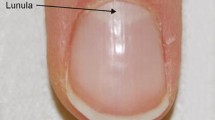Abstract
Tinea incognito is a superficial dermatophytosis that clinically has been modified by misuse and misadministration of corticosteroids, topical or systemic, and less frequently by immunomodulators such as pimecrolimus, either by auto-medication or prescription. As a consequence, the dermatophytosis has an atypical clinical presentation, without the classic signs that orient us to a prompt diagnosis. In these cases, the mycosis may clinically mimic other skin diseases, or may superimpose on a previous dermatosis, usually an inflammatory one. The diagnosis and treatment are the same as for any other dermatophytosis, as well as the etiological agent, so here the most important element is clinical suspicion that will allow adequate and prompt treatment.

Similar content being viewed by others
References
Papers of particular interest, published recently, have been highlighted as: • Of importance
Liu ZH, Shen H. Tinea incognito in an old patient with bullous pemphigoid receiving topical high potency steroids. J Mycol Méd. 2015;25:245–6.
Arenas R, Moreno-Coutiño G, Vera L, Welsh O. Tinea incognito. Clin Dermatol. 2010;28:137–9.
Kye H, Kim DH, Seo SH, Ahn HH, Kye YC, Choi JE. Polycyclic annular lesion masquerading as lupus erythematosus and emerging as tinea faciei incognito. Ann Dermatol. 2015;27:322–5.
Kim WJ, Kim TW, Mun JH, Song M, Kim HS, Ko HC, et al. Tinea incognito in Korea and its risk factors: nine year multicenter study. J Korean Mes Sci. 2013;28:145–51. A complete review and multicenter study.
Verma S, Hay RJ. Topical steroid induced tinea pseudoimbricata: a striking form of tinea incognito. Int J Dermatol. 2015;54:e192–3.
Galipothu S, Kalawat U, Ram R, Kishore C, Sridhar A, Chaudhury A, et al. Cutaneous fungal infection in a renal transplantation patient due to a rare fungus belonging to order Pleosporales. Indian J Med Microbiol. 2015;33:165–7.
Golubovic JB, Otasevic BM, Protic AD, Stankovic AM, Zecevic ML. Liquid chromatography/tandem mass spectrometry for simultaneous determination of undeclared corticosteroids in cosmetic creams. Rapid Common Mass Spectrom. 2015;29:2319–27.
Lo KK. Proper use of topical corticosteroids and topical immune-suppressive agents. Hong Kong Medical Diary. 2006;11:4–5.
Paloni G, Valerio E, Berti I, Cutrone M. Tinea incognito. J Pediatr. 2015;167:1450–e2.
Khosravi AR, Mansouri P, Naraghi Z, Shokri H, Ziglari T. Unusual presentation of tinea cruris due to Trichophyton mentagrophytes var. mentagrophytes. J Dermatol. 2008;35:541–5.
Morales-Cardona CA, Bermúdez-Bula LF. Disseminated tinea incognita mimicking pustular psoriasis. Rev Iberoam Micol. 2012;29:47–8.
Zislova LG, Dobrev HP, Tchernev G, Semkova K, Aliman AA, Chorleva KI, et al. Tinea atypica: report of nine cases. Wien Med Wochenschr. 2013;163:549–55.
Tan Y, Lin L, Feng P, Lai W. Dermatophytosis caused by Trichophyton rubrum mimicking syphilid: a case report and review of literature. Mycoses. 2014;57:312–5. Mentions many of the differential diagnoses usually considered before thinking of tinea incognita.
Tangjaturonrusamee C, Piraccini BM, Vicenzi C, Staracw M, Tosti A. Tinea capitis mimicking folliculitis decalvans. Mycoses. 2009;54:87–8.
Ahmad SM, Wani GHM, Khursheed B. Kerion mimicking bacterial infection in an elderly patient. Indian Dermatol Online J. 2014;5:494–6. Mentions many of the differential diagnoses usually considered before thinking of tinea incognita.
Tirado-Sánchez A, Ponce-Olivera RM, Bonifaz A. Majocchi’s granuloma (dermatophytic granuloma): updated therapeutic options. Curr Fungal Infect Rep. 2015;9:204–12.
Wang T, Hu C, Zhou X, Li C, Zhang H, Lian BQ, et al. Homozygous ALOXE3 nonsense variant identified in a patient with non-bullous congenital ichthyosiform erythroderma complicated by superimposed bullous Majocchi’s granuloma: the consequences of skin barrier dysfunction. Int J Mol Sci. 2015;16:21791–801.
Bakardzhiev I, Chokoeva A, Tchernev G, Wollina U, Lotti T. Tinea profunda of the genital area. Successful treatment of a rare skin disease. Dermatol Ther. 2016;29:181–3.
Kawayami Y, Oyama N, Sakai E, Nishiyama K, Suzutani T, Yamamoto T. Childhood tinea incognito caused by Trichophyton mentagrophytes var. interdigitale mimicking pustular psoriasis. Pediatr Dermatol. 2011;28:738–9.
Claxton NS, Fellers TJ, Davidson MW. Laser scanning confocal microscopy. www.olympusconfocal.com/theory/LSCMIntro.pdf. 24 Nov 2015
Navarrete-Dechent C, Bajaj S, Marghoob AA, Marchetti MA. Rapid diagnosis of tinea incognito using handheld reflectance confocal microscopy: a paradigm shift in dermatology? Mycoses. 2015;58:383–6.
Turan E, Erdemir AT, Gurel MS, Yurt N. A new diagnostic technique for tinea incognito: in vivo reflectance confocal microscopy. Report of five cases. Skin Res Tech. 2013;19:e103–7.
Friedman D, Friedman PC, Gill M. Reflectance confocal microscopy: an effective diagnostic tool for dermatophytic infections. Cutis. 2015;95:93–7.
Lacarrubba F, Verzi AE, Micali G. Newly described features resulting from high magnification dermoscopy of tinea capitis. JAMA Dermatol. 2015;151:308–10.
Knöpfel N, Del Pozo J, Escudero MM, Martín-Santiago A. Dermoscopic visualization of vellus hair involvement in tinea corporis: a criterion for systemic antifungal therapy. Pediatric Dermatol. 2015;32:e226–227.
Lu M, Ran Y, Dai Y, Lei S, Zhang C, Zhuang K, et al. An ultrastructural study on corkscrew hairs and cigarette-ash-shaped hairs observed by dermoscopy of tinea capitis. Scanning. 2015;9999:1–5.
Lourdes LS, Mitchell CL, Glavin FL, Schain DC, Kaye F. Recurrent dermatophytosis (Majocchi granuloma) associated with chemotherapy-induced neutropenia. J Clin Oncol. 2014;32:e92–4.
Coondoo A, Phiske M, Verma S, Lahiri K. Side-effects of topical steroids: a long overdue revisit. Indian Dermatol Online J. 2014;5:416–25.
Author information
Authors and Affiliations
Corresponding author
Ethics declarations
Conflict of Interest
Patricia Chang and Gabriela Moreno-Coutiño declare that they have no conflict of interest.
Human and Animal Rights and Informed Consent
This article does not contain any studies with human or animal subjects performed by any of the authors.
Additional information
This article is part of the Topical Collection on Fungal Infections of Skin and Subcutaneous Tissue
Rights and permissions
About this article
Cite this article
Chang, P., Moreno-Coutiño, G. Review on Tinea Incognita. Curr Fungal Infect Rep 10, 126–131 (2016). https://doi.org/10.1007/s12281-016-0262-5
Published:
Issue Date:
DOI: https://doi.org/10.1007/s12281-016-0262-5




